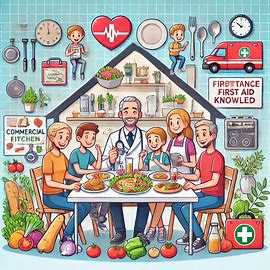Understanding Food Safety Supervisor Certificate And The Effect On Our Commercial Kitchen And Home Kitchen, Especially With Infant And Young Kids.

A Food Safety Supervisor Certificate is more than just a piece of paper; it’s your kitchen’s insurance policy against foodborne disasters. If you’re in the food business, especially handling high-risk foods, this certification is your safety net.
It involves specialized training that arms you with the know-how to spot and manage food hazards, keep tabs on food handling, and build a culture of safety within your team.
In a commercial setting, food safety can’t be left to chance. The regulations make it mandatory for specific food businesses to have a certified supervisor ensuring every steak is cooked right and every salad is handled with care. This isn’t only about ticking a regulatory box; it’s about protecting customers and maintaining your reputation.
Being a gatekeeper of food safety means embracing the role with responsibility. The training teaches you to identify risks before they turn into reality. You become the watchful eye that never blinks, making sure that the standards are upheld each day. This is where your journey begins in transforming your kitchen from just a workplace to a safe haven for food sharing.
But what exactly is in this training? Well, it covers everything from the basics of food hygiene to the advanced nitty-gritty of national food safety laws. These sessions are packed with real-world scenarios and practical tips that stick with you, helping you to watch over your kitchen like a pro. And guess what? Even if you’re not running a big kitchen, this knowledge is pretty invaluable for anyone involved in meal prep.
Impact on Commercial Kitchens: Protecting Public Health

Running a commercial kitchen comes with its own set of challenges, and food safety stands right at the top. The Food Safety Supervisor (FSS) plays a crucial role in this arena, almost like a backstage hero you never knew you needed. FSS ensures that diners enjoy their meals without any risk of foodborne surprises.
When it comes to food safety, it’s about being several steps ahead of potential hazards. An FSS makes sure that everything from sourcing ingredients to serving customers follows the strictest hygiene standards. But what does this look like day-to-day? It starts with overseeing all operations, ensuring everyone from the head chef to the newest server knows the drill when it comes to safety protocols.
A big part of an FSS’s job involves training the team. Just having rules isn’t enough; it’s about making sure everyone understands why those rules matter. Regular training sessions, briefings before shifts, and check-ins are part of the deal. This makes sure the entire kitchen crew is aligned and committed to keeping foodborne illnesses at bay.
Ensuring compliance with safety regulations isn’t just about avoiding fines or passing inspections. This commitment stands as a promise to your customers – a promise witnessed through consistent quality and safety in every dish you serve. It’s about elevating public health standards one plate at a time.
There are plenty of success stories out there, where businesses transformed their food safety culture and saw positive results not just in compliance but also in customer trust and satisfaction. It’s a win-win that pays off when people keep coming back, not just because of the food but because they trust that it’s safe.
Food Safety at Home: Guarding Our Youngest

While the hustle of commercial kitchens might seem a world away from home cooking, the safety principles are just as critical, especially when little ones are involved. Kids, particularly infants, have developing immune systems that make them more vulnerable to foodborne illnesses.
Keeping your home kitchen safe doesn’t require certification but embracing some essential habits can make a big difference. Start with the basics: washing hands thoroughly. It’s surprisingly effective at keeping the germs away. Make sure that every little helper in your kitchen does the same before handling any food.
Watch out for cross-contamination. Designate separate cutting boards for meats and veggies to avoid any unintended mixing. A splash of raw chicken juice on a fresh salad can spell trouble faster than you’d think.
Temperature check is another habitual lifesaver. That nifty food thermometer you got last Christmas isn’t just a gadget—it’s your ally in making sure meats are cooked to a safe temperature, reducing risks significantly.
Storage habits are your next line of defense. Keep perishables promptly refrigerated and label leftovers with dates to avoid mystery meals. A well-organized fridge isn’t just about aesthetics; it’s about keeping track of food safety.
Incorporating these practices turns your home kitchen into a fortress of safety without any fuss. And hey, modeling these behaviors sets a great example for your kids, teaching them lifelong habits that matter.










3 comments